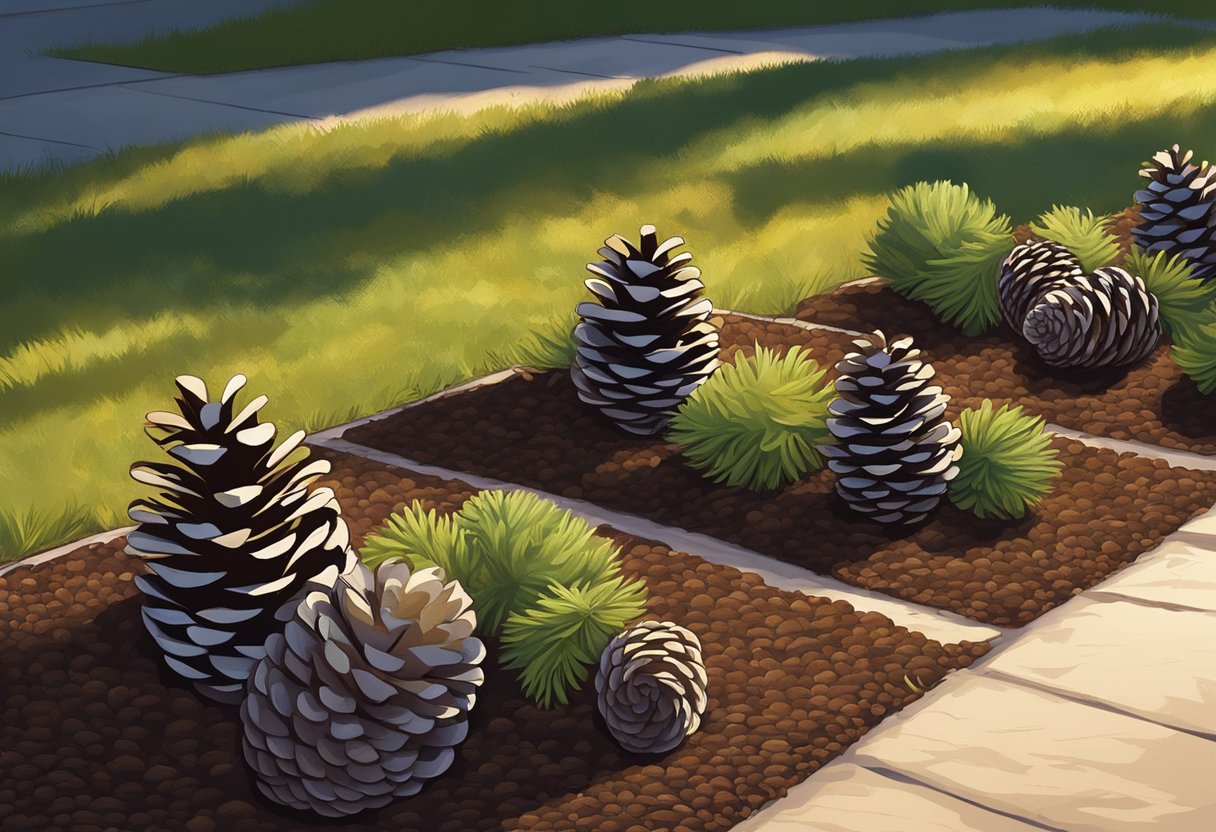As garden enthusiasts, we often seek organic mulch options that are both eco-friendly and beneficial for our gardens. Pine cones, commonly found beneath pine trees, are an overlooked resource that can serve as an effective mulch. Pine cones consist of woody clusters that not only add a rustic aesthetic to the garden bed but also provide practical advantages.

We understand the crucial role mulch plays in maintaining soil moisture, regulating temperature, and suppressing weeds. Utilizing pine cones as mulch can enhance these benefits. These natural byproducts are resilient, offering insulation against extreme temperature changes, and their structure deters weed seed germination. Moreover, pine cones break down slowly, which means they enrich the soil with organic matter over time without the need for frequent replenishment.
Our focus on sustainability also acknowledges that pine cone mulch is less likely to harbor mold and fungus, ensuring a healthier environment for plants. Additionally, the fire-resistant properties of pine cones can be advantageous in areas prone to wildfires. By opting for pine cone mulch, we are choosing a path that aligns with our commitment to organic gardening and the well-being of our garden ecosystems.
Benefits of Pine Cone Mulch in Gardening

When we incorporate pine cone mulch into our gardens, we’re providing significant benefits to our plants and soil. Let’s explore how this natural mulch can be an asset for soil health, plant growth, protection, and the environment.
Soil Health Enhancement
Moisture Retention: Pine cones excel at retaining soil moisture, which is essential for the health of our gardens, particularly during dry spells.
- Prevents Soil Erosion: Their shape and weight help reduce soil and wind erosion.
- Acidic Mulch Quality: As pine cones break down, they can lower the pH of our soil, benefiting acid-loving plants like azaleas and blueberries.
Plant Growth and Protection
Nutrient-Rich Compost: Over time, pine cones decompose into organic material that contributes to a nutrient-rich compost.
- Protection from Temperature Extremes: A layer of pine cone mulch helps regulate soil temperature, safeguarding plant roots from fluctuating conditions.
- Weed and Pest Deterrent: The slow decomposition of pine cones releases tannins that can suppress weeds and dissuade pests.
Environmental Advantages
Natural Resource: Utilizing pine cones as mulch maximizes natural resources, reducing our need for store-bought options.
- Recycling Forest Products: Instead of discarding pine cones, we turn potential waste into valuable mulch for flower beds and shrubs, whether in perennial gardens or around annual plants.
- Enhances Biodiversity: Our use of naturally occurring forest materials can help maintain regional biodiversity.
Practical Considerations for Using Pine Cones as Mulch

In this section, we’re going to examine the effective ways to prepare pine cones for mulching, as well as strategies to manage their unique characteristics during the decomposition process.
Preparation and Application
Before utilizing pine cones as mulch, we must ensure proper preparation to maximize their benefits. First, we collect fallen pine cones and then break them down to desired sizes. While whole pine cones can be used directly, for a more uniform application, we may opt to use a wood chipper to create smaller chunks, which improves soil contact and mulching properties.
Upon applying pine cones, we create a layer approximately 2 to 3 inches thick, taking care to leave some space around plant stems to maintain adequate air circulation. Notably, pine cones are less dense than traditional mulch, which we’ve found allows for good moisture retention while not compacting over time.
-
Crushing Method:
- Whole: Suitable for larger areas with lesser need for aesthetic appeal.
- Chipped: Provides a consistent and neat appearance, ideal for decorative landscaping.
-
Application Method:
- Thickness: 2-3 inches
- Spacing: 1-inch gap around plant bases.
Managing Potential Drawbacks
While pine cones offer a unique mulching option, we also navigate a few potential drawbacks. Due to natural resin present in pine cones, they can be more flammable than other mulch types. Hence, we avoid placing them near fire-prone areas or heat sources.
Moreover, pine cones decompose at a slower rate in comparison to other organic materials. For gardeners who seek quicker nutrient addition to their soil, this may be less ideal. However, the slow decomposition process serves well for a long-lasting mulch solution, and over time, they gradually acidify the soil, which benefits acid-loving plants.
-
Fire Risk Management:
- Avoid proximity to heat sources.
- Maintain fire-safe practices in mulched areas.
-
Decomposition Management:
- Slow release: Ideal for long-lasting mulch.
- Soil pH: Tends to lower pH, favoring acid-loving plants like azaleas and blueberries.
In our experience, although pine cones might not replace traditional wood chips or pine straw entirely, they offer a neutral and natural look that can enhance your garden’s aesthetics while also serving as an effective mulch.